Amid rapid industrial and population growth, Bereans share concerns with City
The Comprehensive Plan 2025 work begins
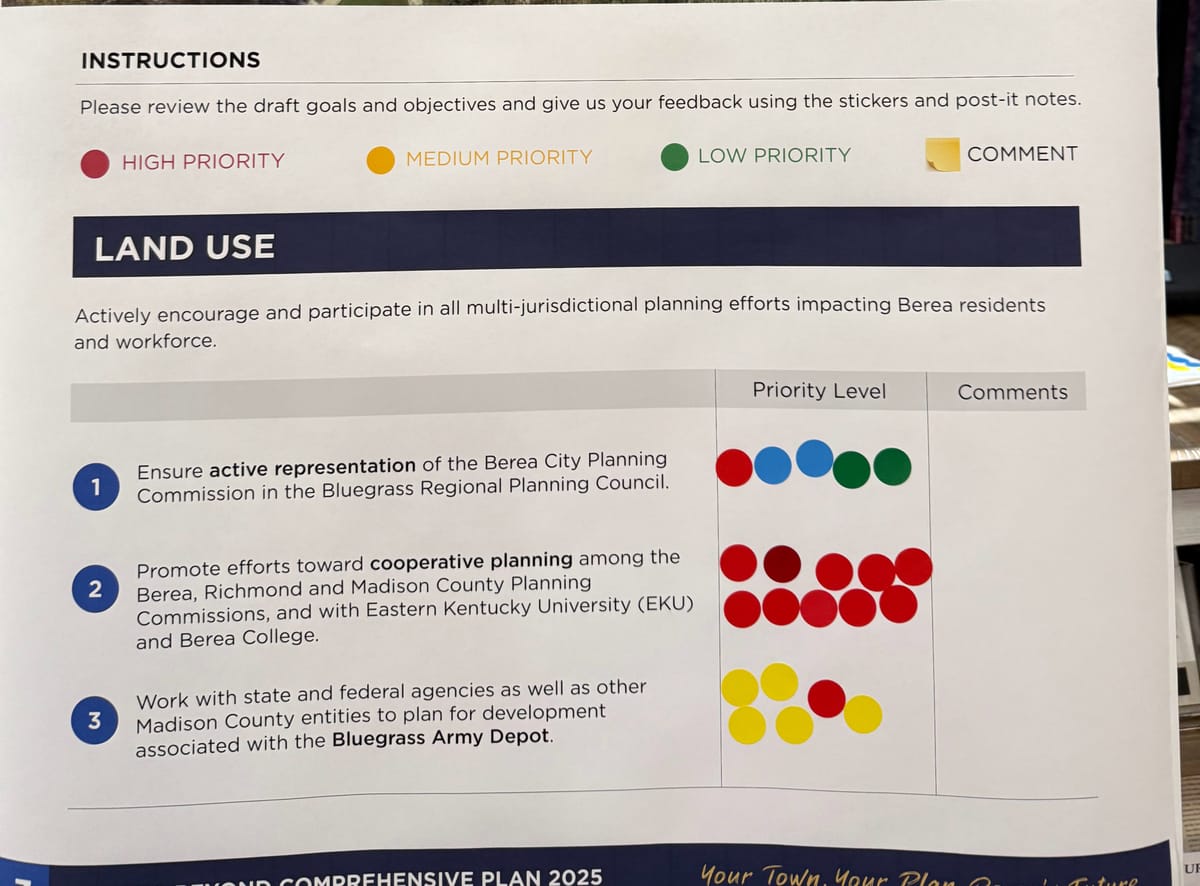
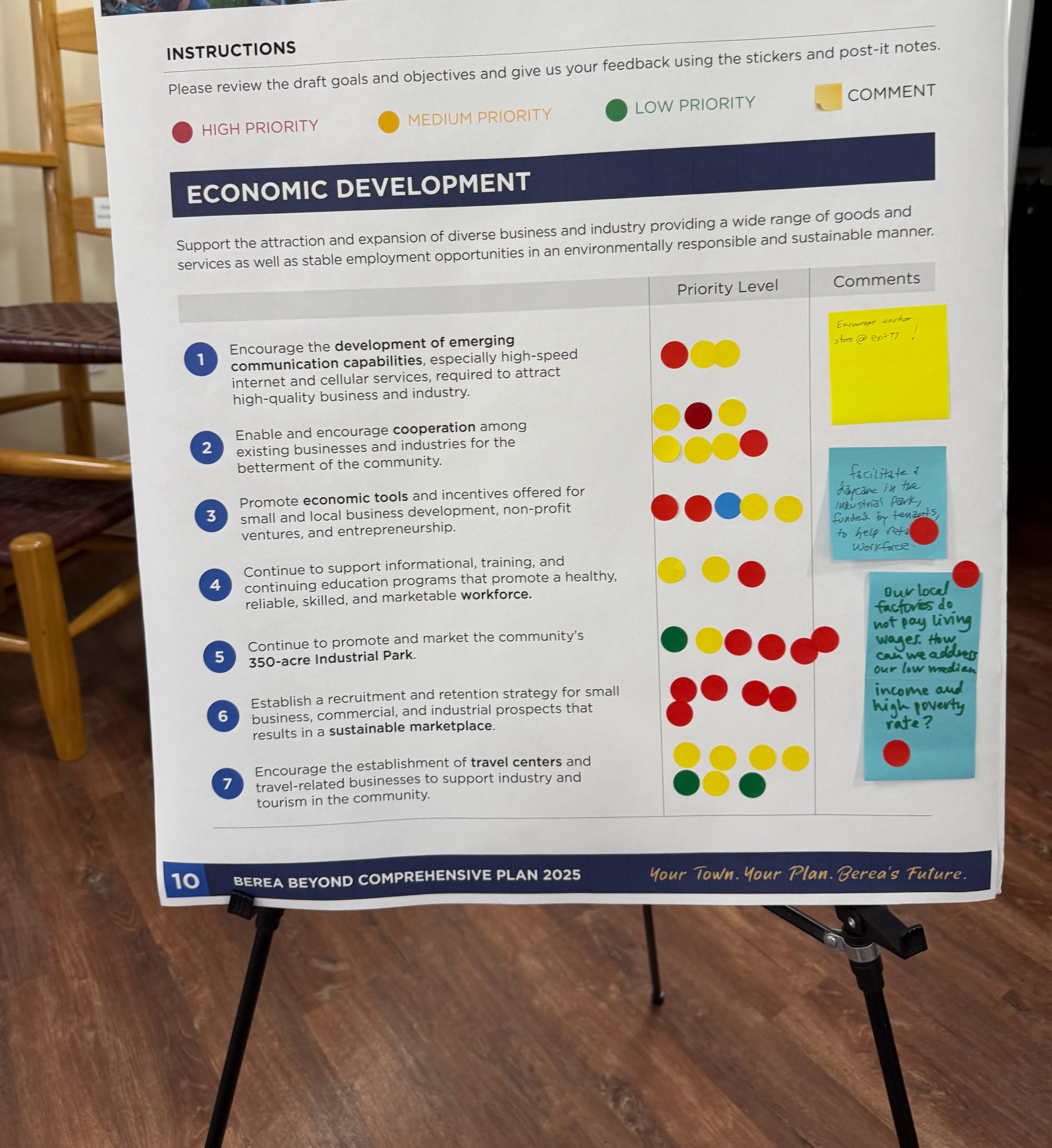
BEREA — On Thursday evening, locals and City officials came together to begin the process of drafting the Comprehensive Plan 2025, the City’s guiding document for the next five years.
From a glance, it seems that economic development and land use, arts and culture, and housing are top of mind for the one hundred or so citizens who turned out to the Berea Gallery for the event. Citizens also endorsed alleviating traffic and providing more public transportation.
Co-hosting the gathering with the Comprehensive Plan Steering Committee was EHI Consultants, the urban planning firm in Lexington that will be managing the planning process throughout.
“We had a really great turn-out, more than I expected,” Mayor Bruce Fraley told The Edge in an interview during the event. “Five years ago was Covid, and we had to do this remotely. Now, there’s a whole lot more exchanging of ideas.”
One hundred is about 0.6% of the roughly 16,500 of the folks who live in Berea. That half a percent filled the room and kept it a-buzz with discussion.
More fun, less traffic
About a dozen topics were up for discussion, running the gamut from the role of industry in economic development to overall land use. Within economic development, tourism seemed to be a hot spot, as was more cultural and outdoor activities such as arts and music festivals.
Posters of the topics and their potential solutions were displayed on easels placed around the room. Attendees were given sheets of colored sticker dots to place next to aspects of the respective topics they believed to be the most important to the City’s quality-of-life. Red dots were for high priority, yellow for medium, and green for low. Post-it notes were also distributed so citizens could elaborate on their choices.
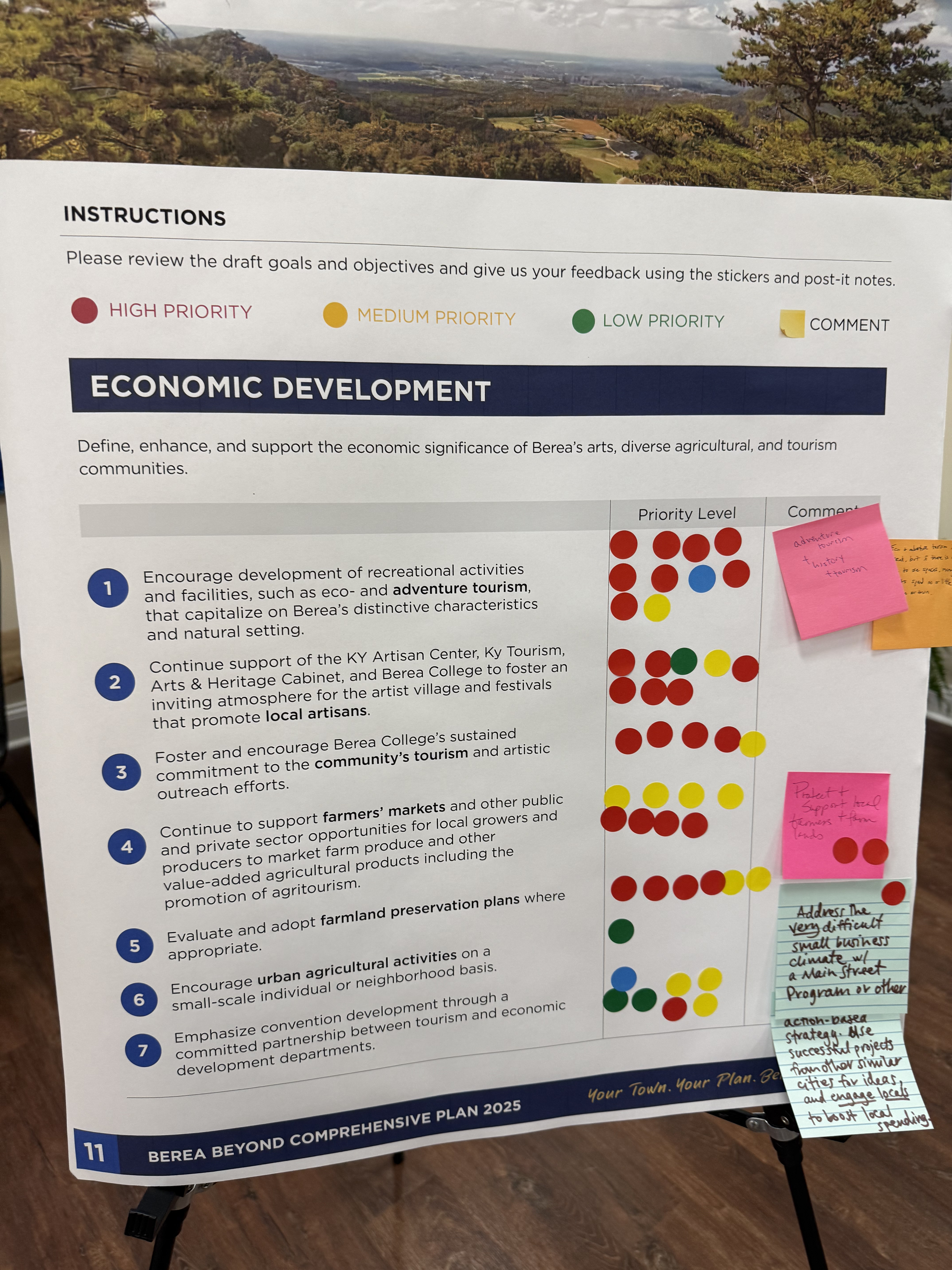
Ed Holmes, founder and president of EHI, told The Edge in an interview during the event that he and his team are already beginning to detect a trend in what citizens want. “What we’re hearing is, people want more restaurants, more local activities and recreation,” Holmes said. “Our goal, but we’ll have to see, is how do you make Berea a very walkable or accessible community that is not entirely dependent on a car?”

Affordable housing at issue
Lack of housing is also emergent, according to Holmes. “Affordable housing seems to be coming up as a topic. It’s difficult to find housing. Traffic, transportation is another one — how to get around the city now that growth is creating more traffic than what people are used to. That’s what I’m hearing in our preliminary discussions,” Holmes said.
“We have to look at how we use land most efficiently,” Martin Richards, Chair of the Planning Commission, and a member of the Steering Committee, told The Edge during the event. “How do we think about density? What about building up? There’s only one building [the Tate Building] that has over two stories.”
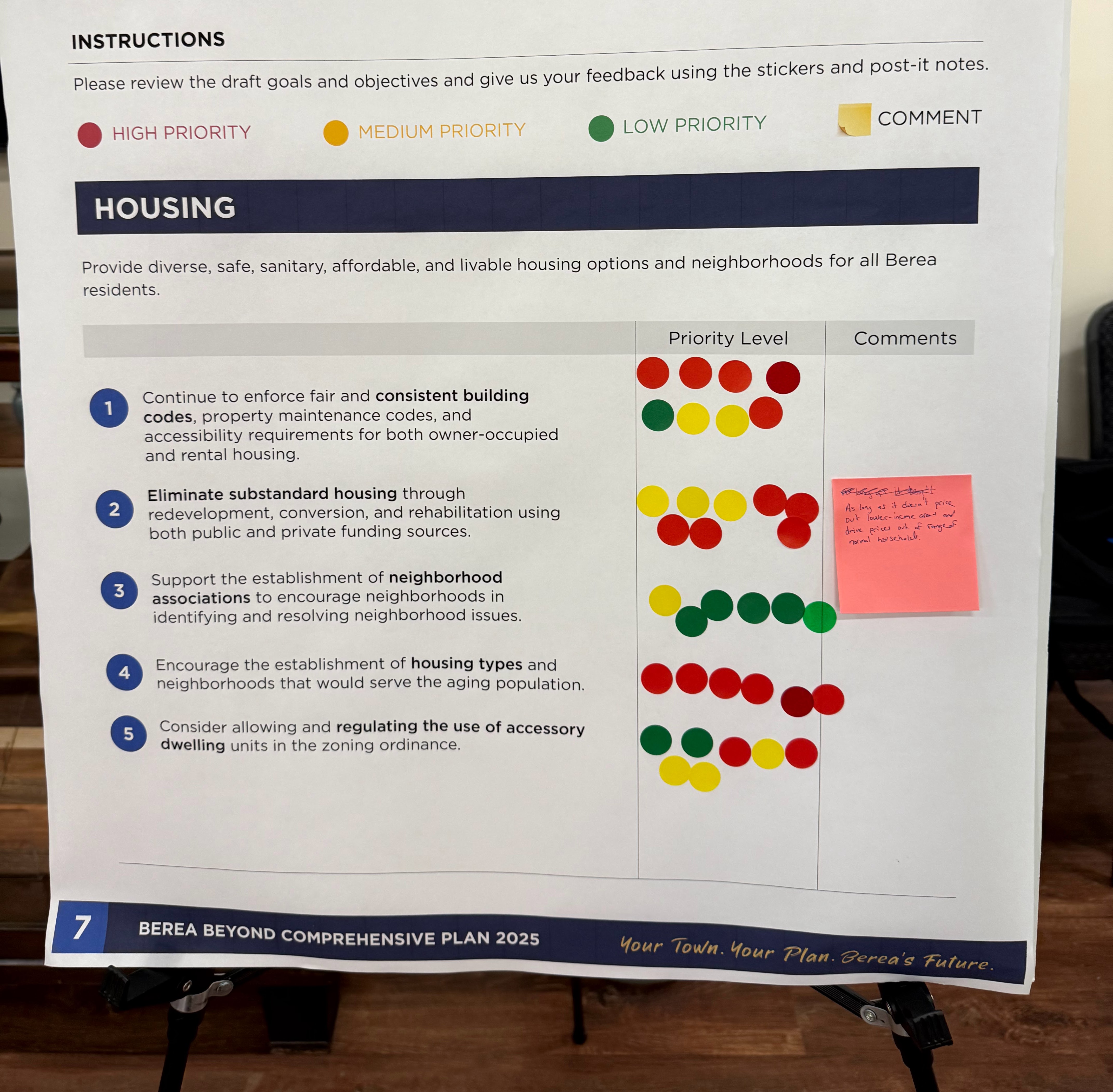
Fraley told The Edge at the event that adequate affordable housing is not just a Berea-issue, but a County one as well, forcing a change in the approach to land management.
“We have to look at being a little bit more flexible with our land management development ordinance and being willing to try things that are a little different in our housing,” Fraley said.
In a previous interview, Richards told The Edge that Berea’s necessary housing inventory is short by 1,100. At the kick-off event, he suggested one way to consider land use would be to balance heavy industry with enough housing that would accommodate a population that would shop in town and hire local services, lifting Berea’s small business economy.
“The more houses, the more services,” he said. Richards also worried about how Berea’s aging population is impacting the housing shortage. “Some of them are living alone in a three bedroom house. For some people, it’s that they have more house than they need or can keep up.” he said.
Rapid growth crisis
Meanwhile, concerns over how to balance housing against industry has lead to county planning commission meetings growing contentious, with some residents upset enough to sue the Fiscal Court over what they claim are ill-advised zoning changes as more developers come before the planning commission with plans for residential housing.
Others have started a popular Facebook group that contravenes the region’s official narratives of economic development.
Madison County’s population grew by 4% between 2020 and 2023, according to a study by Northern Kentucky University. The US Census puts the County’s current population at 99,582. Richmond was shown to have sustained a 7% growth rate in that same three-year period, according to the same study. Berea’s population at 16,436, saw a spike of 1,000 since 2019, according to the 2020 Census. These figures add up to Madison County being among the fastest growing counties in the state, according to the County’s website.
The apparent effect has been to shrink the housing inventory in our region to where it cannot support the sustained population growth. Short-term rentals (AirBnBs, etc.) also have vacuumed up available housing. The Codes and Planning Department told The Edge there aer 25 short-term rentals in town.
Earlier this year, state legislators passed a law that stops municipalities from regulating short-term rentals of less than 30 days, as well as prohibiting local governments from determining how many short-term rentals is too many.

Future planning for housing
Thinking ahead to the development of more housing, Fraley advised large land owners in Berea who plan on making a profit from the sale of their property to get involved in the Comprehensive Plan process.
That’s because zoning changes should be of concern to large land owners as the Comprehensive Plan is hashed out, according to Fraley. “The important thing is for property owners to think about how they would want their property to be zoned in the future,” he said.
He continued: “Let’s say that there is an agricultural zone where there is a farm somebody thinks they might want to have become a residential, or a single residential. If it’s not in the future use plan for that zone, it makes it difficult to get that change made. But, if it’s in the Comprehensive Plan, then it’s aligned, and it makes it easier to change down the road.”
Regionalism favored by leaders
Regional land use was also on the table at the event, a phenomenon in the ascendant across the state. Late last year, as previously reported, Berea entered into an interlocal agreement with the Lexington-Fayette Urban County Government, and Scott and Madison counties to pool resources, especially land, in order to create a series of regional industrial parks to compete for a bigger share of the industrial pie with other highway-intense regions in other states.
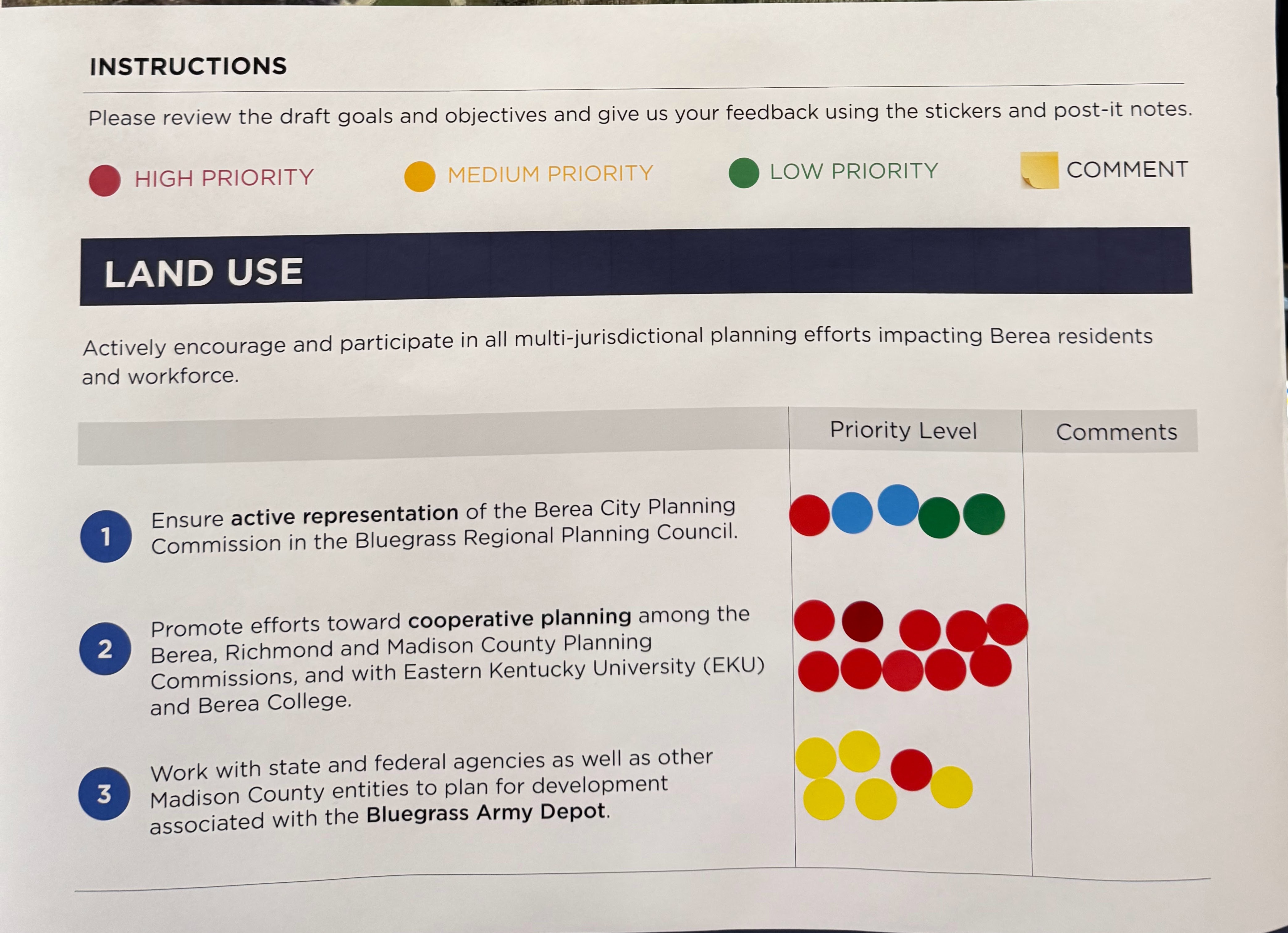
Doing so requires land, and a lot of it, creating not only tension with housing advocates, but those who fear the County is rushing to favor developers over citizens.
“Is it really about more housing for Madison County, or is it about the almighty dollar?” a citizen recently asked the Fiscal Court in a regularly scheduled meeting earlier this week.
In Berea where the first industrial park will be built on about 300 acres of land, the land was already owned by the Berea Industrial Authority, so there has been no remarkable public outcry.
A second parcel in Madison County — about 800 acres not far from the Kentucky River, is now under contract with the Fiscal Court for use as a state-designated industrial “mega-site”. Officials have already sent out a request for proposals from engineering firms to develop it and some citizens are not happy.
Meanwhile, Berea also pays one dollar per citizen to participate in CommerceLEX, a regional body formed to promote the Bluegrass as a whole, to outside industry.
Next steps
Berea resident and entrepreneur, Sune Frederiksen said of the Plan that because every one thing affects the whole, “It’s very important to see it from a holistic point of view. You can’t just pick two or three areas,” he said, adding that without follow-up dialogue sticking dots on a poster is meaningless. “If I put a dot here, no one knows what I mean,” he said. “And it’s important to speak to people in town you don’t know, and to get another perspective.”
Holmes, who told The Edge he previously has worked with other small college towns, said that next steps include EHI meeting with City department heads and their staff to assess what citizens said they think matters most and turn that feedback into an outline to be fleshed out further. More public participation will be invited as the process continues.
The Edge is a Berea’s source for real journalism. Become a paid subscriber and never miss a story.
This story was updated on Friday, June 6, at 3:47PM.
